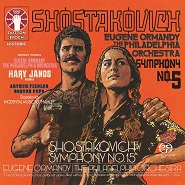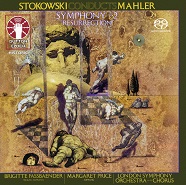Thanks for the clarification and feedback!
I really really wish D/V would provide 30-second samples of their SACD quad content, so I wouldn’t feel like I was diving in blind. I’m so tempted to place a big classical order, but I’m afraid the discs won’t end up discrete enough for my tastes. The only D/V classical(ish) SACD I’ve taken a chance on so far is the Bernard Herrmann film score one, and although I love his music, I didn’t find a ton of discrete excitement to my ears.
So... if I’m significantly more of a discrete guy than an immersive guy... if a priority to me is stuff tickling my ears from the rears (not that I want a totally incoherent mix, of course)... if I’m a big fan of the mixes on, say, the Elton John SACDS, or Fragile, or Larks’ Tongues In Aspic, or (in the D/V library) the Earth Wind & Fire 2fer or Tale Spinnin’... which of D/V’s classical issues are likely to make me the happiest?
Or are my ears the problem, and I just need to recalibrate my expectations for classical quad?
I think you need to recalibrate your expectations, but only to an extent.
I can only speak for the RCA and Columbia Masterworks titles that Dutton Epoch have released, but I'm not sure you'll get much classical quad that has the same kind of dry 4-corner ping-pong action you find in the pop stuff from the same era, but at the same time it doesn't mean that it's ambient surround by any means.
This has as much to do with the difference in approach to recording as anything: with pop music, everything was close-mic'ed in the recording studio, and the musicians were physically separated from each other to an extent, so for example if you just listened to a guitar track on the multitrack, you would hear almost zero drums, or bass, or vocals or anything. That means during the mixing process, you can pan every instrument as far apart from the others as you like, and you don't get any "smearing" (ie the instrument 'leaking' into the mics of other other instruments at all) in the surround soundfield.
Contrast that with classical recordings, where, generally speaking, most or all of a large symphony orchestra (which could number from the dozens up to nearly a hundred musicians) all played their instruments in a large room (concert hall or recording studio) at the same time. Now instead of creating the quad effect during mixdown, the majority of the effect was created by how the musicians were arrayed during the recording - for example on the Epoch release
Levine Conducts Mahler the musicians were arranged in a circle around the conductor's podium, and I think a similar arrangement was used for the Tilson-Thomas/Cleveland Symphony Orchestra recording of Orff's
Carmina Burana. Having done that, they'd set up their 16 or 24 microphones to try and pick up each section of instruments as discretely as possible, but given (again) that you've got everyone playing in the same room, when the 1st violins play, the microphones for the adjacent instruments are going to pick them up a little bit. and when the tympani guy or cymbal smasher (these are technical terms, trust me) get their one moment in the spotlight, every microphone in the place is going to get some of it. This is partly unavoidable, but it's also partly by design, I think - part of the classical "ethos" is that you record in these huge venues renowned for their acoustics, and you want to pick up some of those acoustics, the reverberations, which give you a sense of the size and grandeur of the environment the music is being played in.
Having said all that, I think generally speaking the Columbia Masterworks quads are more discrete (in a pop sense) than the RCA recordings, probably (like their pop counterparts) to satisfy the limitations of the SQ matrix encoding system. There are some (it seems like they're mostly early ones from '72-'73, in the MQ 30xxx to MQ 32xxx catalog number range) that are ambient mixes (or "concert hall sound" as Columbia called it) with the orchestra in front and reverb in the rears, but the vast majority are truly immersive "middle of the orchestra" mixes.
I'm sure some of the more classically edumacated posters here like
@humprof and
@ubertrout can chime in with better suggestions, but as someone with a pop background the Epoch releases I've enjoyed most so far from a surround perspective have been the ones that are a bit more contemporary in nature -
Copland Conducts Copland: Appalachian Spring (although to my ears the Chavez
Piramide part is awful, it sounds like two hippopotamouses having a conversation) and the Tilson-Thomas conducting Gershwin that's part of the 3fer that includes Carmina Burana.
I think all the E. Power Biggs titles (
Rheinberger: Two Concertos and
Music for Organ, Brass & Percussion, which was marketed as a "Quadraphonic Spectacular") are very discrete, as is Boulez conducting Stravinsky's Pulcinella Suite, which was mixed for quad by Larry Keyes, who did so many of the great Columbia pop quad mixes. Another one of Columbia's quad showoff albums was
Boulez Conducts Bartok: Concerto for Orchestra ("The Symphony Orchestra in Quadraphonic Surround Sound - A New Chapter in the History of Recording" it proclaimed!) and as you can see from
the cover, it's really trumpeting (I'm killing it with the music puns lately) its surround sound credentials. Zukerman playing Vivaldi's
Four Seasons and Four Concertos is also very discrete, but it was a bit too mellow to keep my attention for two album's worth of material.
That's a start anyway - I think as a fellow classical neophyte the best advice I can give you is try and figure out which composers and/or pieces you like first, and then look for surround sound versions, because if you don't like the music, how discretely it's coming out of your rear speakers will be a moot point.







